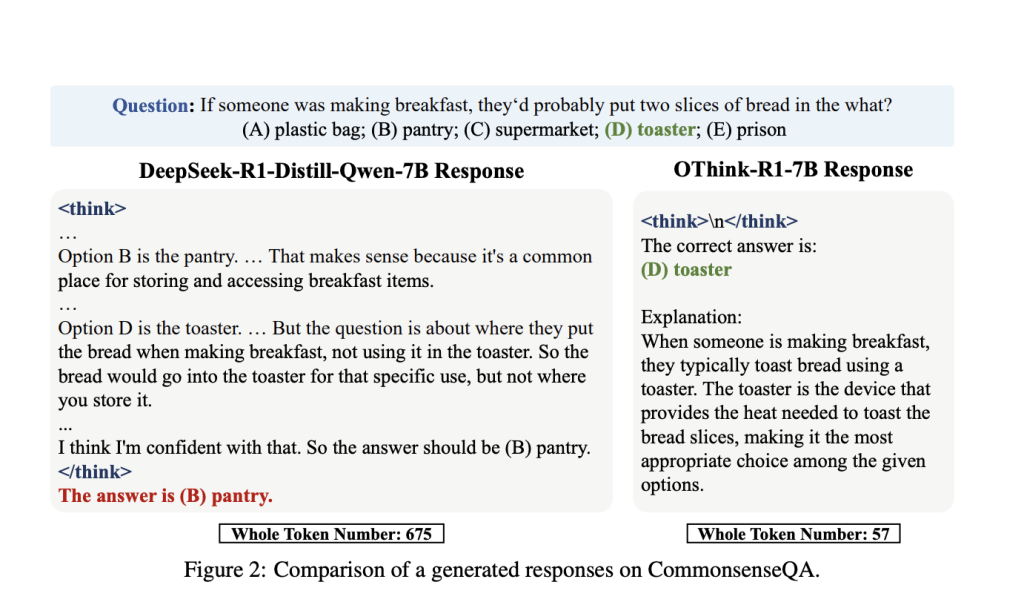The Inefficiency of Static Chain-of-Thought Reasoning in LRMs
Recent LRMs achieve top performance by using detailed CoT reasoning to solve complex tasks. However, many simple tasks they handle could be solved by smaller models with fewer tokens, making such elaborate reasoning unnecessary. This echoes human thinking, where we use fast, intuitive responses for easy problems and slower, analytical thinking for complex ones. While LRMs mimic slow, logical reasoning, they generate significantly longer outputs, thereby increasing computational cost. Current methods for reducing reasoning steps lack flexibility, limiting models to a single fixed reasoning style. There is a growing need for adaptive reasoning that adjusts effort according to task difficulty.
Limitations of Existing Training-Based and Training-Free Approaches
Recent research on improving reasoning efficiency in LRMs can be categorized into two main areas: training-based and training-free methods. Training strategies often use reinforcement learning or fine-tuning to limit token usage or adjust reasoning depth, but they tend to follow fixed patterns without flexibility. Training-free approaches utilize prompt engineering or pattern detection to shorten outputs during inference; however, they also lack adaptability. More recent work focuses on variable-length reasoning, where models adjust reasoning depth based on task complexity. Others study “overthinking,” where models over-reason unnecessarily. However, few methods enable dynamic switching between quick and thorough reasoning—something this paper addresses directly.
Introducing OThink-R1: Dynamic Fast/Slow Reasoning Framework
Researchers from Zhejiang University and OPPO have developed OThink-R1, a new approach that enables LRMs to switch between fast and slow thinking smartly, much like humans do. By analyzing reasoning patterns, they identified which steps are essential and which are redundant. With help from another model acting as a judge, they trained LRMs to adapt their reasoning style based on task complexity. Their method reduces unnecessary reasoning by over 23% without losing accuracy. Using a loss function and fine-tuned datasets, OThink-R1 outperforms previous models in both efficiency and performance on various math and question-answering tasks.
System Architecture: Reasoning Pruning and Dual-Reference Optimization
The OThink-R1 framework helps LRMs dynamically switch between fast and slow thinking. First, it identifies when LRMs include unnecessary reasoning, like overexplaining or double-checking, versus when detailed steps are truly essential. Using this, it builds a curated training dataset by pruning redundant reasoning and retaining valuable logic. Then, during fine-tuning, a special loss function balances both reasoning styles. This dual-reference loss compares the model’s outputs with both fast and slow thinking variants, encouraging flexibility. As a result, OThink-R1 can adaptively choose the most efficient reasoning path for each problem while preserving accuracy and logical depth.
Empirical Evaluation and Comparative Performance
The OThink-R1 model was tested on simpler QA and math tasks to evaluate its ability to switch between fast and slow reasoning. Using datasets like OpenBookQA, CommonsenseQA, ASDIV, and GSM8K, the model demonstrated strong performance, generating fewer tokens while maintaining or improving accuracy. Compared to baselines such as NoThinking and DualFormer, OThink-R1 demonstrated a better balance between efficiency and effectiveness. Ablation studies confirmed the importance of pruning, KL constraints, and LLM-Judge in achieving optimal results. A case study illustrated that unnecessary reasoning can lead to overthinking and reduced accuracy, highlighting OThink-R1’s strength in adaptive reasoning.

Conclusion: Towards Scalable and Efficient Hybrid Reasoning Systems
In conclusion, OThink-R1 is a large reasoning model that adaptively switches between fast and slow thinking modes to improve both efficiency and performance. It addresses the issue of unnecessarily complex reasoning in large models by analyzing and classifying reasoning steps as either essential or redundant. By pruning the redundant ones while maintaining logical accuracy, OThink-R1 reduces unnecessary computation. It also introduces a dual-reference KL-divergence loss to strengthen hybrid reasoning. Tested on math and QA tasks, it cuts down reasoning redundancy by 23% without sacrificing accuracy, showing promise for building more adaptive, scalable, and efficient AI reasoning systems in the future.
Check out the Paper and GitHub Page. All credit for this research goes to the researchers of this project. Also, feel free to follow us on Twitter and don’t forget to join our 100k+ ML SubReddit and Subscribe to our Newsletter.
The post OThink-R1: A Dual-Mode Reasoning Framework to Cut Redundant Computation in LLMs appeared first on MarkTechPost.
Source: Read MoreÂ



